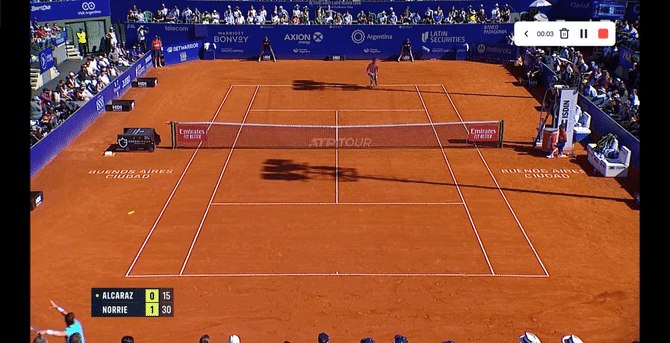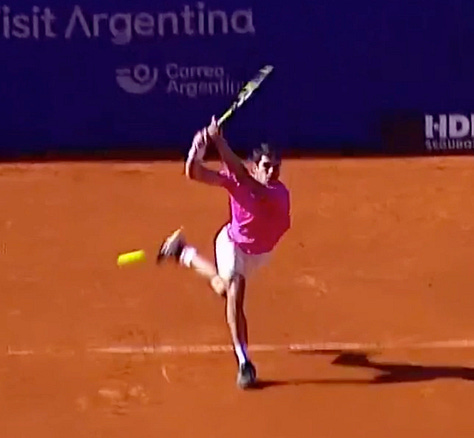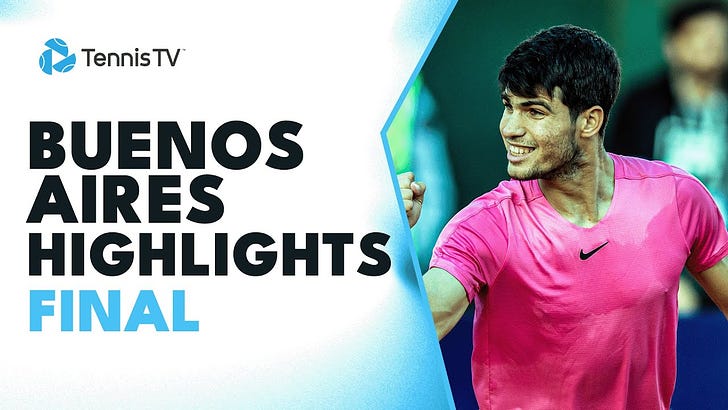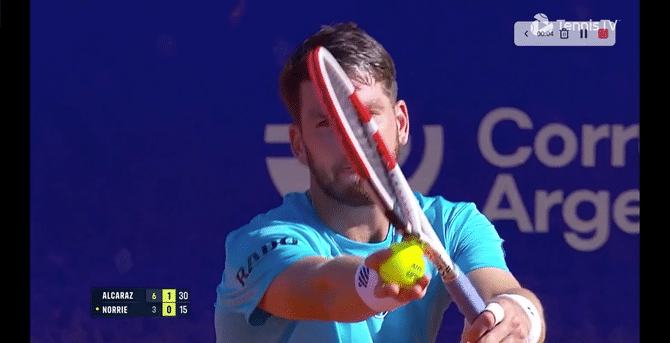Alcaraz x Norrie: Buenos Aires Final
Alcaraz's catch 22—defence to offence speed—local v global maximums
World #2 Carlos Alcaraz defeated Cameron Norrie 6/3 7/5 in the final of the Buenos Aires ATP 250 in his first tournament back from injury. It was the 19-year-old Spaniard’s first title of the season and seventh overall. Alcaraz now leads his H2H against Norrie 4-1.
Back in March of last year I wrote a short piece on Alcaraz as he was starting to make waves on the tour. An excerpt:
When watching Alcaraz play you get a sense his game resembles certain aspects of Federer, Nadal, and Djokovic; that he occupies some middle ground of a Venn diagram of the Big-3. For starters, Alcaraz sees his style in the mold of Federer: "I think my playing style is reminiscent of Roger Federer's... I love to be aggressive and I like to come to the net to close the point."
Alcaraz loves to attack, but you can see that he marries that aggressive instinct with a determination to get started in a lot of points by returning from very deep in the court; something akin with Nadal’s return tactic. The below graphic was from the 2022 Miami Masters (which Alcaraz won).
This lightning-quick switch from defence to offence was on full display in the early exchanges of the match:

His ability to take balls early and change direction makes him a nightmare to navigate defensively. Here he shows that ability on the backhand:

The very next point Alcaraz hit an unreturned first serve at 227km/h (seems slightly off). Then he followed that up with this:
It’s the near-endless options that make him so hard to play when he strings this kind of form together. Players are forced into a Catch-22 situation; standing deeper to handle his power just opens up more space for his drop shot, and should you hold the baseline he is just going to rush you. Alcaraz won 5/7 points on his drop shot attempts for the match.
On return, Alcaraz would drop back deep to give himself time to rip a hard return, and then move up the court and look to attack. He wastes no time and takes the first opportunity to strike. It didn’t really matter even if Norrie found the backhand:
In response, Norrie tried to steal more time and play more aggressively—quite uncharaceristic of him—which ended up bleeding errors. The commentators noted after the rushed backhand below:
“That’s just pressure from the opponent…It’s a basic miss from Norrie, but you know the context of this is this is he is feeling so much pressure…Alcaraz is a bit of a whirlwind as an opponent. You don’t really know what’s coming next.”
I’ve often noted how Djokovic builds pressure in subtle ways, using depth and line balls rather than outright power or rushing:
Corner defence married with controlled depth and subtle change-of-direction may not make for good highlight reels, but it allows him [Djokovic] to effortlessly tear apart quality top-20 opposition without getting out of mid-gears.
But Alcaraz’s pressure is more akin to Federer. It’s the relentless attack from every part of the court, and then using every part of the court to expose his opponent. This is the key distinction between Alcaraz and his company (Sinner, Auger-Aliassime, Tsitsipas, Rublev, Fritz, etc.). None can hold a candle to his variation.1
And that same variety separates himself from his peers on defence as well:

At 6/3 5/2 the match was heading for a pretty quick finish, but to Norrie’s credit he fought the break back and forced Alcaraz to break again at 5-5. A look at the final stats.

Alcaraz bled quite a few forehand errors in that hiccup late in the second set, but I think the key distinction here is that Alcaraz imposed his game on Norrie far more than Norrie did to Alcaraz. As the commentator mentioned midway through the second set:
“For Alcaraz—who’s numbers are expectingly good—a lot of the points he is losing are on his terms as well.”
The Spaniard misses of course, but he misses with a lot of purpose and intent. Norrie had to red-line his aggression to a level he just wasn’t comfortable with.
Local v Global Technical Maximums
In motor learning literature, learning skills—especially complex skills that are numerous in their degrees of freedom, like tennis strokes—are often hard to perfect because it is not always clear where in the skill the movement was off, and how one should correct it. There is no consensus out there on the one best way to hit a particular shot, and often the subtle differences in a swing are a delicate balance of tradeoffs, but by looking for similarities in the best shots, we can identify the features that continually show up. Features that consistently appear in the best strokes can then be said to represent the “global” maximum of technique, whereas features that continually appear to be sub-optimal may only represent a "local" maximum.2 No matter how "talented" one is, wielding the local maximum will always have ceiling effects. As I explained in the Adelaide Final analysis between Djokovic and Korda, Alcaraz's backhand also features the locked-wrist follow through that I think helps direct the ball with control.



Yet Alcaraz starts his backhand outside his hands (like Korda); something I think is sub-optimal compared to the fuller takeback of Djokovic (but may allow him to take it earlier, so tradeoffs). So there is still a distinction between Djokovic’s backhand and Alcaraz’s, and Djokovic is clearly the global maximum when it comes to backhands.
Similarly, the Alcaraz forehand exhibits the same features that we see in many great forehands; racquet-tip up, wrist slightly extended:


The Alcaraz title puts him firmly back on track after a few months on the sideline, and you’d have to like his chances to back up this title with a deep run in Rio. Both men are the top seeds in the Rio ATP500 that starts today.
Although I think Rune is worthy of note. He shows a lot of promise with slice/drop shots/and an ability to come forward and play great at the net.
Lohse, K., Miller, M., Bacelar, M., & Krigolson, O. (2019). Errors, rewards, and reinforcement in motor skill learning. In Skill Acquisition in Sport (pp. 39-60). Routledge.









Loved reading, as always, and never ceases to wow me how effortlessly Carlos glides up the court to storm his opponent with such ease. Think he only sometimes fires long up the line on his FH if the ball in is low and short enough, but on clay, Cam's BH sits up too nicely for that.
As a defence of Cam's FH aggression, he's actually changed and improved his swing pattern and parts of his footwork to create a better working, attacking mechanism that allows him to hit better inside-in shots (great/important for improved ad court dominance on HCs, as seen at United Cup) and down the line on clay to stretch opposition (last year during his Lyon title run, he was floating up those changes of direction and teeing opponents up for counterpunches in behind).
I think he actually executed that aggression really well early on but Carlos' serve shut him out and eventually knocked his confidence. His footing deep into the corners on clay is a weak point, so, even as a leftie, he's rarely properly settled to handle the ad kicker; his BH can't absorb pace or carry any weight against deuce 1st serves, so s+v's & +1s are easy to win with, and the compensating he does for that side on clay by stepping up was shut down by the far more extreme kick to the body he was facing on the day.
Thanks for that piece Hugh, always a pleasure reading you say positive things about Carlos' groundstrokes. One question that crossed my mind. You seem pretty bullish on Taylor Fritz's backhand (I saw a post on tennis warehouse where you put his and nole's aside) but, since you haven't made a dedicated piece to him (either that or I missed it) I would like to ask you quickly what you think his ceiling is? What are his weaknesses ? Because to me, he is in a category where I just can't see him dominate the game like Carlos, Jannik or Rune.